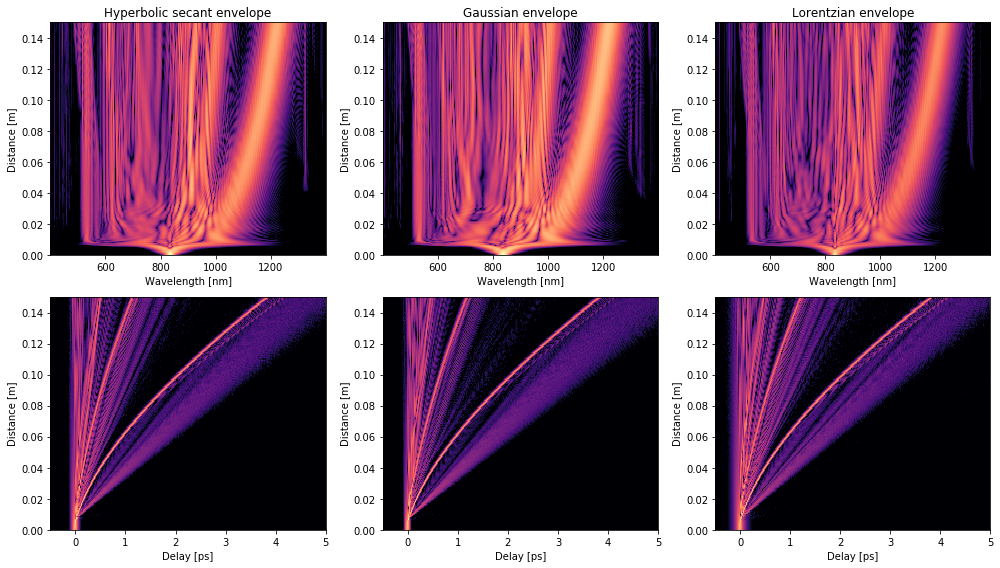GNLSE: Nonlinear optics modeling tool for optical fibers¶
gnlse-python is a Python set of scripts for solving Generalized Nonlinear Schrodinger Equation. It is one of the WUST-FOG students projects developed by Fiber Optics Group, WUST.
Complete documentation is available at https://gnlse.readthedocs.io.
Installation¶
Using pip¶
Instal the latest version
pip install gnlse
or pick appropriate version as v2.0.0
pip install gnlse==2.0.0
From scratch¶
Create a virtual environment using
python -m venv gnlseorconda.Activate it:
. gnlse/bin/activateClone the GitHub repository:
git clone https://github.com/WUST-FOG/gnlse-python.gitInstall the package with all requirements:
pip install .or add the relevant path to your
PYTHONPATHenviroment variable.
Dependencies¶
The following Python packages are required to install gnlse module. During instalation of package the latest version of each of listed below package will automatically be installed if missing:
matplotlib>=2.2.2
numpy>=1.14.3
scipy>=1.1.0
pyfftw>=0.10.0
hdf5storage>=0.1.15
tqdm>=4.11.2
Usage¶
We provide some example Python scripts in the examples subdirectory. For
instance, running test_Dudley.py demonstrates supercontinuum generation in
an optical fiber using three different input pulse envelopes.
cd gnlse-python/examples
python test_Dudley.py
A visualisation, pictured in the screenshot below, is then displayed.

Examples:
More examples can be found in the examples subdirectory.
Major features¶
A modular design: the solver framework was decomposed into different components and one can easily construct a customized simulations by accounting different physical phenomena, ie. self stepening, Raman response.
The main core of the module is derived from the RK4IP MATLAB script written by J. C. Travers, H. Frosz and J. M. Dudley, published [DT10].
Support for three Raman response functions:
blowwood[BW89],linagrawal[LA06] andhollenbeck[HC02].Support for two dispersion operators: calculated from a Taylor expansion and calculated from effective refractive indices.
A number of example scripts in the
examplessubdirectory:
plot_input_pulse.py, plotting various input pulse envelopes,
plot_Raman_response.py, plotting supported Raman response functions in the time domain,
test_3rd_order_soliton.py, demonstrating the evolution of spectral and temporal characteristics of a third-order soliton,
test_dispersion.py, an example of supercontinuum generation using different dispersion operators,
test_nonlinearity.py, an example of soliton fission using different GNLSE and Modified GNLSE accounting mode profile dispersion, (take into account mode profile dispersion),
test_Dudley.py, an example of supercontinuum generation using different input pulse envelopes,
test_gvd.py, showing pulse broadening due to group velocity dispersion,
test_import_export.py, an example of saving and loading simulation results to and from a *.mat file,
test_raman.py, showing solition fission in case for different Raman responses,
test_spm.py, an example of self-phase modulation,
test_spm+gvd.py, demonstrating generation of a first-order soliton.
Release information¶
v2.0.0 was released on April 26, 2022. The main branch works with Python 3.7.
Version |
Date |
Notes |
|---|---|---|
2.0.0 |
April 26, 2022 |
|
1.1.3 |
February 13, 2022 |
|
1.1.2 |
August 30, 2021 |
|
1.1.1 |
August 28, 2021 |
|
1.1.0 |
August 21, 2021 |
|
1.0.0 |
August 13, 2020 |
|
Citation¶
If you use a code please cite us:
Paragraph …
@misc{redman2021gnlsepython,
title={gnlse-python: Open Source Software to Simulate Nonlinear Light Propagation In Optical Fibers},
author={Paweł Redman and Magdalena Zatorska and Adam Pawłowski and Daniel Szulc and Sylwia Majchrowska and Karol Tarnowski},
year={2021},
eprint={2110.00298},
archivePrefix={arXiv},
primaryClass={physics.optics}
}
Contributing¶
Pull requests are welcome. For major changes, please open an issue first to discuss what you would like to change.
Please make sure to update examples and tests as appropriate.
Acknowledgements¶
gnlse-python is an open-source project, contributed to by researchers, engineers and students of the Wrocław University of Science and Technology, as part of Fiber Optic Group’s nonlinear simulation projects. The Python code was partially based on MATLAB code, published in [DT10], available at http://scgbook.info/.
License¶
This project is licensed under the terms of the MIT License.